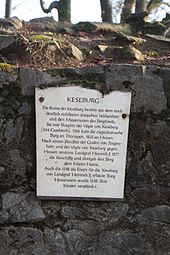Keseburg
| Keseburg | ||
|---|---|---|
| Alternative name (s): | Keseberg Castle | |
| Creation time : | before 1144 | |
| Castle type : | Hilltop castle | |
| Conservation status: | Remains of the keep and moat | |
| Standing position : | Nobles, counts | |
| Place: | Ederbringhausen | |
| Geographical location | 51 ° 7 '41.3 " N , 8 ° 53' 0.2" E | |
| Height: | 385 m above sea level NHN | |
|
|
||
The Keseburg or Keseberg Castle near Ederbringhausen , a current part of the municipality of Vöhl in the north Hessian district of Waldeck-Frankenberg ( Germany ), is a ruin of a former hilltop castle in the Kellerwald that has only survived in remnants .
Geographical location
The Keseburgruine is located on the western edge of the Kellerwald , to the right of the Eder valley , around 6 km south of its influence in the Edersee . In a lonely forest location, it is located about 1.2 km east of the village of Ederbringhausen and 385 m above sea level. NHN high North Extension of the natural park Keller Edersee located Kesebergs ( 431.2 m ). About 1 km south, beyond the Keseberg, is Hessenstein Castle .
From the Keseburgruine one looks to the west to the confluence of the Orke and the Eder at Ederbringhausen and to the west and north into a part of the Edertal.
history
Keseburg Castle was probably built in the 11th century by the Counts of Ziegenhain and Reichenbach . It is first mentioned in 1144 as the seat of the Bailiffs of Keseberg (Caseberch) . In 1186 the castle came through the marriage of Lukardis, a daughter of Count Gozmar II von Ziegenhain-Reichenbach, with Friedrich von Ziegenhain , a son of Landgrave Ludwig II of Thuringia, together with Wildungen Castle , to Friedrich, who then became Count called by Wildungen.
Sophia, the daughter of Friedrich and Lukardis, married the burgrave Burchard VI. "Kurzhand" from Magdeburg, and before 1227 he sold the castles Keseburg and Wildungen to Landgrave Ludwig IV (the saint) of Thuringia. Since he did not have the consent of his wife and her family, a dispute between the Ziegenhainern and Ludowingern broke out . It was not until 1233 that Count Berthold I von Ziegenhain reached an agreement with Landgrave Konrad von Thuringia , who administered the Hessian possessions of the Ludowingers for his brother, Landgrave Heinrich Raspe , on the Ziegenhain inheritance of his uncle Friedrich von Ziegenhain, and the castle finally fell to the Landgraviate Thuringia. The Geismar court, however, in whose area the Keseberg was located, remained the Mainz fief of the bailiffs of Keseberg. A court ruling from 1244 once again confirmed that the land on which the castle stood was a landgrave, while the surrounding area belonged to the Haina monastery.
After the death of Heinrich Raspe in 1247, with which the Ludowinger family died out in the male line , Archbishop Siegfried III tried . of Mainz to collect the landgraves' fiefdoms. Burgrave Burchard VI. von Magdeburg had died in the meantime, and his widow, Countess Sophia von Wildungen, as the actual heiress, had planned to sell both castles to Mainz. In 1247 she ceded her rights to the castles of Keseburg and Wildungen to the archbishop, but the relatives of her deceased husband refused to recognize this change of ownership, and both castles remained in the landgrave's possession.
In the Thuringian-Hessian War of Succession (1247–1277), which broke out after Heinrich Raspe's death, the Bailiffs of Keseberg allied themselves with the Counts of Ziegenhain and opposed the Hessian claims to fiefdom. Landgrave Heinrich I of Hesse then destroyed the castle in 1277 and gave the castle hill and the remains of the castle to the Haina monastery for free ownership. The Lords of Keseberg submitted to the Landgrave and had to move to their farm in Geismar.
Landgrave Heinrich II had the nearby Hessenstein Castle built as a replacement between 1342 and 1348 in order to have a fortified official residence for his local bailiffs, and the lords of Keseburg became castle men there . In 1360 Widekind, Vogt von Keseberg, gave back his fiefdom, part of the Geismar office, to Archbishop Gerlach of Mainz . The Keseburg remained in ruins.
Current condition
The ruin consists of the remains of the wall of the keep and the double moat that is still clearly visible .
Individual evidence
- ↑ a b c The Keseburg , on voehl.de
- ^ Keseburg , information board on the remains of the castle wall, on commons.wikimedia.org
literature
- August Heldmann: The governors of Keseburg. In: Journal for Hessian History (ZHG) 25 NF 15 (1890), pp. 1–54
- Rudolf Knappe: Medieval castles in Hesse: 800 castles, castle ruins and castle sites. 3. Edition. Wartberg-Verlag, Gudensberg-Gleichen 2000, ISBN 3-86134-228-6 , p. 149 f.
- Karl Hermann May: On the history of Nassau vassals. In: Nassau Annals. Yearbook of the Association for Nassau Antiquity and Historical Research 67, Wiesbaden 1956, pp. 18–32
- Rolf Müller (Ed.): Palaces, castles, old walls. Published by the Hessendienst der Staatskanzlei, Wiesbaden 1990, ISBN 3-89214-017-0 , p. 347 f.
Web links
- Keseberg Castle, Waldeck-Frankenberg district. Historical local dictionary for Hesse (as of June 27, 2014). In: Landesgeschichtliches Informationssystem Hessen (LAGIS). Hessian State Office for Historical Cultural Studies (HLGL), accessed on November 22, 2016 .
- State Office for Monument Preservation Hessen (Ed.): Burgruine Keseberg In: DenkXweb, online edition of cultural monuments in Hessen
- Keseburg , on burgenlexikon.eu
- The Keseburg on voehl.de





